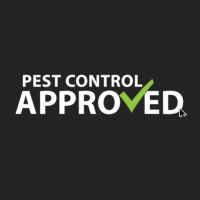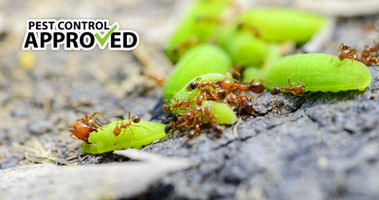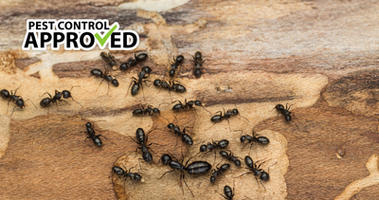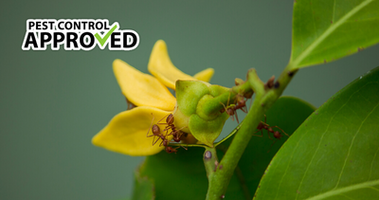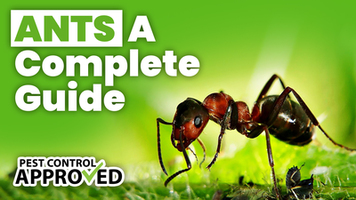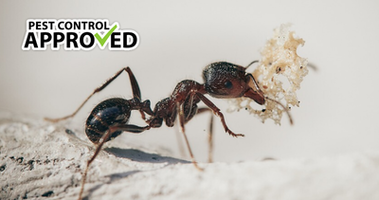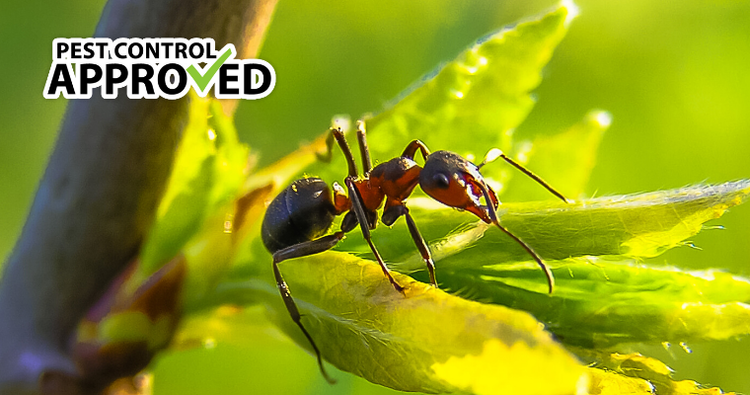
Ant Control
Ants come in a variety of different species. Over 12,000 species exist all over the world. With unique structures and capabilities, ants are an amazing wonder. There is estimated to be a million ants per person living on this earth! Even though these creatures can be such a marvel, they can also be more then a little nuisance around our homes. Here you will learn a little information about ants, their habitat, ways you can be proactive in keeping them away, ways you can prepare for a service and what do after a service is completed.
About Ants
One of the amazing capabilities of an ant is superhuman strength. They are able to lift and carry from 10-50 times their own weight. Depending on the species some are more strong then others-the Asian weather ant for example can carry 100 times its own body weight.
Just like humans ants are farmers, most commonly seen with the farming of aphids. Ants will protect aphids from other dangers and harbor them in their nests from weather conditions in order to keep honeydew in stock. Ants are the only species besides humans known to farm others.
There are certain kinds of ants that are known to be slave makers. After invading nearby colonies and taking their residents they use them as workers for their own group purposes. Slave making ants are tasked with replacing workers and newly recruited ants build for their new colony.
Ants are fairly harmless for the most part and very important to our ecosystem. Providing healthy growth of farms, gardens and lawns, their underground tunnels aerate the earth. Ants also aid in the decomposition of compostables and are beneficial with maintaining other damaging pests such as aphids around our gardens.
Ants live underground in mounds of dirt or earth, in trees and under stones in structured nest colonies. Sometimes they may even home inside the walls and crevices of homes and buildings. Because ants nests are located deeply burrowed underground, they are able to survive through tough winters and other challenging environmental conditions. After a long winter ants begin work to rebuild their population and community. For that reason, come spring there is a large increase in activity.
Ants are very social insects. The colony is lead by one or multiple queen ants. The queen’s task is to ensure the colony survives by laying thousands of eggs. Other ants are the workers. Workers are females with no wings that don’t reproduce. Workers are tasked with scavenging for food, caring for the queen’s ant lings, keeping the nest intact and protecting the colony among other responsibilities. The queen ant has the longest life expectancy keeping the same colony alive for years while the workers die off. For this reason, it can be difficult to solve an ant problem with home solutions. Contacting a professional is always the easiest, safest and best way to eradicate the infestation.
Ants In Our Homes
Ants set up camp around their needs. Places that provide shelter, food, and water are top priority. Seeking provisions outside the habitat are common which is why you often see long trails of workers wandering across your yard and sometimes even across your floors or counter tops in your home. Ants have many different food sources. Depending on the time of the year these favorites may change. After winter, before ants prepare to mate and lay eggs, they need a diet rich in protein. Foraging for dead animals or bugs and other scraps from human garbage including leftover meats and even grease and butter. Towards the end of summertime as the colony expands and workers are hard at work, they tend to seek carbohydrates to supply them with energy. Crumbs of bread, pieces of vegetables among other remnants of human food provide just the thing. For this reason, it is important to be keeping a tidy home and yard as to not attract ants to their needs.
The worst part about finding an ant in your home is knowing there’s most likely more as they work, journey and live in packs. Most ants travel from their colonies in search of supplies. By following a pheromone chemical trail, ants form an assembly line to and from their nest. By following this trail, you may be able to find their colony in order to exterminate the infestation. Home remedies (such as using orange peels, peppers and other herbs for example) don’t work and outdoor nests aren’t easy to wipe out without the proper chemicals. Flooding nests multiple times may be effective in relocating a colony, but the queen must be forced to move or be killed in order to manage a nest. Remember a professional will know all the answers to your questions and how to properly treat your dilemma.
Ants are so small it can be fairly easy for them to find entry points to your house. From tiny holes in your screen doors, openings or cracks around electrical outlets and outdoor plumbing fixtures as well as gaps under your doors. There are many different access points that allow ants entry. They may also gain entry by being accidentally brought in by you! Bringing in garden vegetables and herbs, fresh cut flowers from your yard, potted plants- could be anything that was left outside then being brought in. Properly sealing any cracks and gaps as well as doors is one way to keep ants out of your home. Other preventative ways can include keeping a clean kitchen with floors swept, making sure that water is directed away from the house and foundation and also ensuring a tidy yard is in order removing any wood piles or items where ants may chose to establish their nest.
Common Household Ants
Common household ants found in our homes don’t pose serious problems. Most ants dwell in our gardens and yards outside keeping soil aerated and regulating other harmful pests like aphids. Out of over a thousand different species of ants only a few are likely to take refuge in homes and even less are known to cause any significant damage or sting people. Although most ants don’t pose more of a problem then being a nuisance, they can still be the cause of spread bacteria. The biggest problem an ant infestation may cause are due to carpenter ants. These ants are very damaging as they burrow through wood causing structural damage to homes, trees and decorative furniture. Fire ants are another worrisome infestation as they tend to be aggressive and will sting anything that interferes with their way. Understanding and knowing what kind of ant you’re dealing with is important to be proactive and in treating your ant problems.
Common household ants include carpenter ants, large yellow ants, pharaoh ants, cornfield ants, thief ants and pavement ants.
Carpenter Ants
Carpenter ants are either black or red and black, ranging from 3/16 to 1/2 inch in length. They eat other bugs, meat and anything sweet such as syrup, jams, honey and sugar. Wood is not a food source; they chew the wood into sawdust in order to burrow creating their tunnels. Carpenter ants nest in insulation, hollow spaces such as wall voids or doors, under roofing or in attic beams, around tubs, bathroom tiles, showers, sinks and dishwashers and around wet or rotting wood including trees. Applying insecticide right into the nest, replacing ruined wood and taking care of any moisture problems will help manage carpenter ants.
Large Yellow Ants
Large yellow ants are yellowish to reddish brown around 3/16 inches in length. They are rarely seen inside as they don’t travel indoors in search of food. When crushed these ants emit a lemon smell. Large yellow ants feed on honeydew. They nest in soil under concrete, bricks, large rocks and logs as well as in soil beneath buildings and in and around foundation walls. To manage large numbers, use insecticide labeled for flying insects found only in aerosol containers.
Pharaoh Ants
Pharaoh ants are light yellow to red with a darker rear (the thorax) and are 1/16 inches long. They eat a variety of foods mostly those containing fats and grease. Unlike other ants they also feed on toothpaste and soap as well as other foods others wouldn’t touch. Many kinds of sweets and dead bugs are other sources. Pharaoh ants nest strictly indoors in warm buildings mostly found in apartments, hospitals, and schools etc. They don’t survive outdoors. These ants’ nests are very difficult to find as they live in small spaces, crevices and cracks, basement boards and counter tops. Nesting in warm and dark areas close to sources of moisture such as bathrooms or the kitchen. These ants are very difficult to manage and hiring a professional is strongly recommended for these pests. Insecticides can actually cause new colony growth. A pest control company will have specific bait effective with eliminating pharaoh ants.
Cornfield Ants
Cornfield ants are light to dark brown in color and around 1/10 inch in length. They feed on sweets such as honeydew and live or dead insects. These ants nest in soil specially lawns, under large rocks, bricks, concrete and rotting trees and logs. They are rarely found colonizing in houses. In order to manage these pests treating nests and the perimeter of your house with spray is the most effective.
Thief Ants
Thief ants are yellow to light brown and about 1/20 inch in length. These ants are very commonly mistaken for pharaoh ants. Protein and greasy foods like nuts, meats and cheese are their common food source. Being so small they are able to get into almost any food container. Thief ants are very difficult to locate. They reside in rotting wood and soil, and in small areas indoors such as behind baseboards and counter tops as well as cracks in walls and cabinets. Baiting is the most effective with the management of ants that feed on grease. If the nest is located outside, then treating the perimeter of your house will stop these ants from seeking food sources from inside your homes or building.
Pavement Ants
Pavement Ants are brownish red to black in color and about 1/8inch in length. Common food sources include insects, nuts, breads, meats, sweets and pet food. These ants nest in driveways, concrete, sidewalks, large rocks and logs. They’re usually found under homes and may enter through cracks in the concrete or foundation. In order to manage infestation, nests need to be treated. If the nest can be found, you can treat the perimeter of your home with spray. Commercial baits are most effective with ants that feed in grease.
Less common household ants include field ants, odorous house ants, acrobat ants, and false honey ants.
Field Ants
Field ants are red, brown, or black or a mix of these colors and are about 1/8 to 1/4 inch in length. These ants feed on honeydew and sweets as well as insects, dead and alive. Commonly confused with carpenter ants but not likely to be found searching for food sources indoors. Field ants are nest in mounds of built up soil and are only found nesting outdoors. To manage these pests granular pesticide is needed to treat their nests and may need multiple treatments.
Odorous House Ants
Odorous house ants are brown to dark brown and around 1/10 inch in length. Common food sources include sweets and insects. They will forage indoors for sweet items and other foods. Odorous house ants can nest in walls, voids, under carpets, under stones, boards and logs as well as almost anything laying around on the ground. These ants are odorous when crushed but only smelt when close to your nose as it is faint. In order to manage these ants their colony must be eliminated. Search around outside for these nests under objects like stones and logs etc. and treat accordingly. Commercial grade baits are most effective with these ants that feed on sweets.
Acrobat Ants
Acrobat ants can be various ranges of yellow, brown and black in color and are around 1/8 inch in length. Some food sources are sweets, meats and other bugs. They are known to be found nesting in rotting wood and dead trees and sometimes in soil under large rocks. Indoors they reside mostly in window frames and other rotten wood as well as crevices in walls and foam insulation boards. In order to manage an infestation, check areas with rotting wood and window frames- if possible, remove and repair these areas. Appropriate spray is needed to treat their nests. Injecting insecticide dust into wall voids with nests indoors and spray perimeter of building with insecticide.
False Honey Ants
False honey ants are light to dark brown in color and around 1/8 inch in length. These ants prefer sweet food sources like honeydew. They nest in open and well shaded areas in soil. False honey ants don’t reside indoors and are almost never found to be nesting under large rocks, stones and logs etc. To effectively manage these pests, locate the mound, their nest, and treat accordingly. Using commercial grade baits are the most effective in treating these ants that feed on sweets.
Ways To Be Proactive
Remember understanding the ant species your dealing with isn’t the only way to help handle an infestation. Ensuring the nest is properly treated is important because in order to solve your problem the queen that lays the eggs is the one who must be eliminated, and she never leaves the nest. Heavy doses of liquid pesticide that can seep down and reach the queen are best in eradicating the issue. Always follow labels and instructions when dealing chemicals. Spraying visible ants does little in correcting an infestation as new workers will just appear following that pheromone trail left by the others. When the nest is hidden behind a wall insecticide dust will need to be inserted possibly through drilling small holes in the wall. Make sure your product is labeled and proper for indoor use. Using baits are most efficient as worker ants will feed and bring back the poison to their colony. Bait is most effective when other competing food sources are eliminated. One downside of baits is it can take a longer time from weeks to even months to kill a whole colony. Identifying which ant you’re dealing with important to ensure the proper bait is being used to target specific species as not all ants are attracted to all baits.
Non chemical ways to prevent ants can include vacuuming, keeping clean counters and floors, cleaning out recycling and garbage bins and reducing entry points. Ensure all food is properly stored in airtight sealed containers, including pet food. Kibble is a great source of protein and grease and will attract ants as its perfect for their needs. Water and vinegar can be used to wash away pheromone chemical trails left by travelling ants. Using soapy water moats around planters or sticky barriers around entrances can also be helpful as well as applying insecticides around the outside of your home or building. A pest control technician is specialized in these infestations and will be able to answer any questions as well as solve your problem.
Preparing For A Service
If a pest control service is chosen, you’ll receive the best results. Being prepared prior to a service you may be provided will work best when following these instructions. Ensure all counters are clear of food sources, spills and crumbs to allow bait to be their primary source. Vacuuming will pick up any unseen crumbs. Make sure garbage are promptly emptied and the bins are properly rinsed before each new use including recycling bins (specially bins used for bottles where juice and pop syrups may have leaked into the bottom). Keep dishes consistently cleaned and off counters where scraps may provide alternate food sources. Ensure any food left out, including pet food, is properly stored away in plastic sealed containers. Lastly be prepared to show the technician where you’ve seen any ants and any found nests. Ask a lot of questions to understand the treatment and ways to be further proactive as well as any post treatment recommendations and instructions to be followed.
Post-Treatment
After a treatment be sure to keep following above instructions. Be patient as bait can take time to be fully effective and make sure you aren’t spraying any insecticides or killing any seen ants as they are used to bring the bait back to the nest. Included with not killing the ants in order to keep their pheromone trails intact don’t use nay strong cleaners or chemicals. These trails are important to draw the ants to bait stations.
For more information on ants, check out our Complete Guide On Ants

